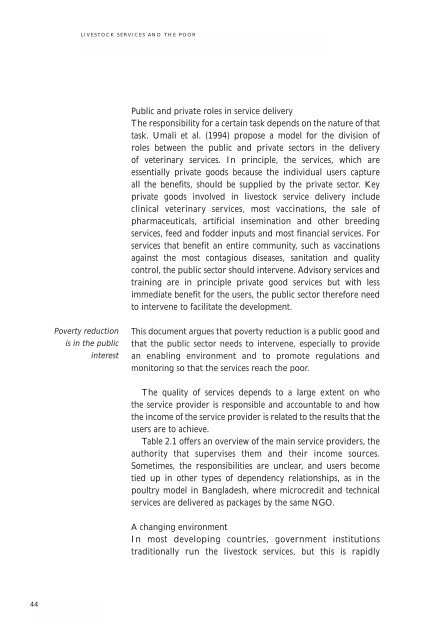Livestock Services and the Poor: A global initiative - IFAD
Livestock Services and the Poor: A global initiative - IFAD
Livestock Services and the Poor: A global initiative - IFAD
Create successful ePaper yourself
Turn your PDF publications into a flip-book with our unique Google optimized e-Paper software.
44<br />
LIVESTOCK SERVICES AND THE POOR<br />
Poverty reduction<br />
is in <strong>the</strong> public<br />
interest<br />
Public <strong>and</strong> private roles in service delivery<br />
The responsibility for a certain task depends on <strong>the</strong> nature of that<br />
task. Umali et al. (1994) propose a model for <strong>the</strong> division of<br />
roles between <strong>the</strong> public <strong>and</strong> private sectors in <strong>the</strong> delivery<br />
of veterinary services. In principle, <strong>the</strong> services, which are<br />
essentially private goods because <strong>the</strong> individual users capture<br />
all <strong>the</strong> benefits, should be supplied by <strong>the</strong> private sector. Key<br />
private goods involved in livestock service delivery include<br />
clinical veterinary services, most vaccinations, <strong>the</strong> sale of<br />
pharmaceuticals, artificial insemination <strong>and</strong> o<strong>the</strong>r breeding<br />
services, feed <strong>and</strong> fodder inputs <strong>and</strong> most financial services. For<br />
services that benefit an entire community, such as vaccinations<br />
against <strong>the</strong> most contagious diseases, sanitation <strong>and</strong> quality<br />
control, <strong>the</strong> public sector should intervene. Advisory services <strong>and</strong><br />
training are in principle private good services but with less<br />
immediate benefit for <strong>the</strong> users, <strong>the</strong> public sector <strong>the</strong>refore need<br />
to intervene to facilitate <strong>the</strong> development.<br />
This document argues that poverty reduction is a public good <strong>and</strong><br />
that <strong>the</strong> public sector needs to intervene, especially to provide<br />
an enabling environment <strong>and</strong> to promote regulations <strong>and</strong><br />
monitoring so that <strong>the</strong> services reach <strong>the</strong> poor.<br />
The quality of services depends to a large extent on who<br />
<strong>the</strong> service provider is responsible <strong>and</strong> accountable to <strong>and</strong> how<br />
<strong>the</strong> income of <strong>the</strong> service provider is related to <strong>the</strong> results that <strong>the</strong><br />
users are to achieve.<br />
Table 2.1 offers an overview of <strong>the</strong> main service providers, <strong>the</strong><br />
authority that supervises <strong>the</strong>m <strong>and</strong> <strong>the</strong>ir income sources.<br />
Sometimes, <strong>the</strong> responsibilities are unclear, <strong>and</strong> users become<br />
tied up in o<strong>the</strong>r types of dependency relationships, as in <strong>the</strong><br />
poultry model in Bangladesh, where microcredit <strong>and</strong> technical<br />
services are delivered as packages by <strong>the</strong> same NGO.<br />
A changing environment<br />
In most developing countries, government institutions<br />
traditionally run <strong>the</strong> livestock services, but this is rapidly

















